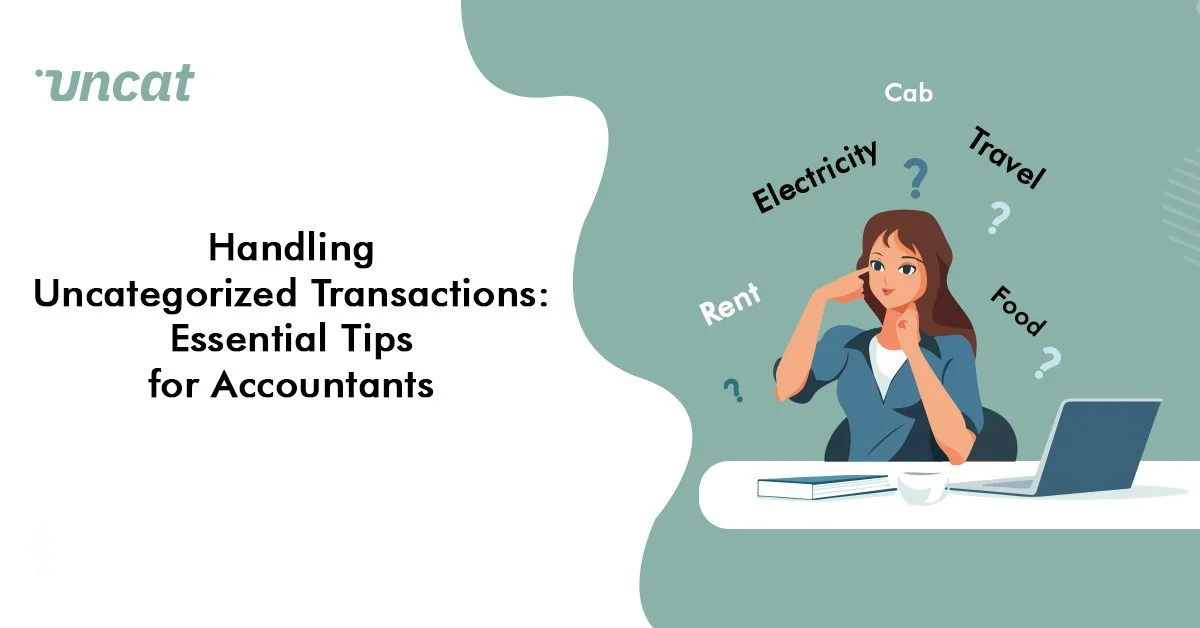Handling Uncategorized Transactions: Essential Tips for Accountants
For accountants, the saying "time is money" isn't just a cliché—it's a daily reality. As we balance deadlines and sort through piles of receipts to unravel financial details, few things are more draining than handling unplanned transactions.
"Unknown charges" and "mystery debits" can wreak havoc on our workflow, slow us down, create reporting headaches, and even result in overlooked tax deductions. But don't worry! Today, we'll tackle those uncategorized transactions head-on, free ourselves from unnecessary stress, and, most importantly, save valuable time.
What Are Uncategorized Transactions?
Uncategorized transactions are financial entries that haven't been assigned a proper category, such as groceries, rent, or office supplies. These often remain unclassified due to unclear bank descriptions, misplaced receipts, or delayed processing. Regardless of the reason, unassigned transactions disrupt orderly financial records and create complications until they are appropriately addressed.
The Consequences of Uncategorized Transactions
Leaving transactions uncategorized can lead to a series of financial challenges. Here's how they can affect various aspects of your business:
Accurate Financial Reporting: Try assessing your company's financial health without knowing where your funds are flowing. That's exactly what uncategorized transactions do—they prevent you from identifying spending patterns, making informed decisions, or spotting cost-saving opportunities.
Missed Tax Deductions: Unclassified transactions can obscure legitimate business expenses. Without proper categorization, you might overlook deductible items on your tax return, potentially leading to unnecessarily high tax bills.
Decision-Making Challenges: Unclear spending data turns financial decision-making into guesswork. Without the ability to accurately track trends or identify growth areas, it becomes nearly impossible to allocate resources effectively, leaving you with an uncertain financial outlook.
Client Dissatisfaction: Chasing down uncategorized transactions can be time-consuming and frustrate clients, casting doubt on your competence as an accountant and damaging your professional reputation.
Increased Risk of Fraud: Unusual transactions could be red flags for financial misconduct within your company. When expenses remain uncategorized, it might be a sign that someone is misusing your resources and further investigation is needed.
7 Time-Saving Tips for Managing Uncategorized Transactions
Here’s a smart strategy to handle uncategorized transactions effectively and win back your precious time:
Tip #1: Do Not Utilize the Manual Spreadsheet
While Excel is useful for basic tasks, it isn't ideal for categorizing transactions, as it can be time-consuming, prone to errors, and lacks advanced automation features. That's why it's worthwhile to experiment with accounting software like QuickBooks, Xero, FreshBooks, and Wave, which enable you to connect to your bank accounts and credit cards, automatically categorizing entries and setting up rules for recurring expenses. With their help, you can get everything organized more efficiently—your eyes will thank you.
Tip #2: Take Advantage of Batch Process Optimization Solutions
Don't let uncategorized transactions pile up. Schedule regular review sessions—weekly or biweekly, depending on your workload—to address them all at once. This approach prevents the task from becoming overwhelming and allows you to focus on other projects throughout the week.
Tip #3: Simply Ask the Client
Never hesitate to reach out to clients to clarify any unknown charges on an invoice or statement. A quick email or call can save hours of digging and ensure accurate transaction categorization. Most clients appreciate the attention to detail and opportunity to help.
Tip #4: Automate Your Reminders
Make use of accounting software to set up reminders, allowing you to review and categorize transactions regularly. This way, you'll stay on top of things and avoid creating a backlog.
Tip #5: Train Your Team and Yourself
Invest time in training both yourself and your team on proper categorization practices. Cover topics like handling receipts, identifying transactions by name, and dealing with ambiguous charges. Clear guidelines will simplify the process and make everyone's life easier.
Tip #6: Use a Transaction Categorization Tool
If your current accounting software falls short in the categorization department, consider using standalone transaction categorization tools. These can quickly and accurately categorize even complex or unusual expenses, saving you time and headaches.
Tip #7: Keep Up with Industry Trends
Keep updated on the latest best practices and innovations that can improve your workflow and reduce uncategorized transactions. Continuous learning is essential for making wise financial decisions and staying ahead in the market.
Bonus Tip: How to Use Uncat to Manage Your Workflow and Categorize Transactions
Uncat is an all-in-one platform created to simplify accounting processes, including tasks such as transaction categorization, receipt processing, and client communication, all within a single, user-friendly interface.
How can Uncat transform your workflow and make transaction categorization much easier?
Smart Categorizing: Through the use of machine learning technology, Uncat lets you sort your transactions quickly and accurately.
Digital Receipt Management: Uncat allows users to snap, store, and process receipts electronically, cutting out manual data entry.
Seamless Client Collaboration: You can securely share financial data with clients, granting them direct access to view or update their records in Uncat.
Improved Communication: The Uncat platform enables you to keep all client conversations in one place, eliminating the need to juggle emails and phone calls.
Saved Time: By automating routine tasks, Uncat helps you significantly reduce the time and effort needed to manage clients' finances, freeing you up for more strategic work.
Take Control of Your Transactions!
Uncategorized transactions may seem like a lot to tackle, but with the right strategies and tools, you can manage them more efficiently—saving both time and peace of mind. By using our tips, you'll smooth out your workflow, reduce errors, and improve your overall productivity as an accountant. Now you're all set to handle whatever transactions come your way and improve your financial management!

